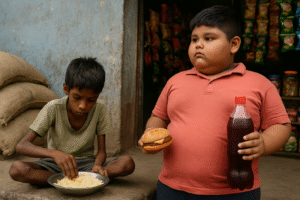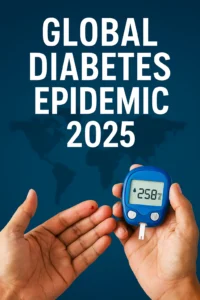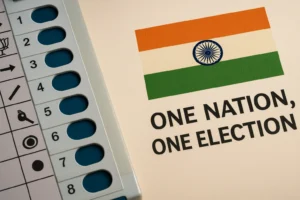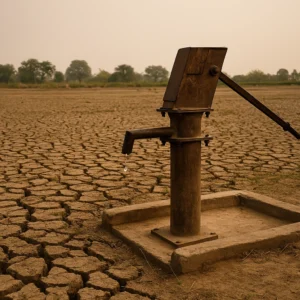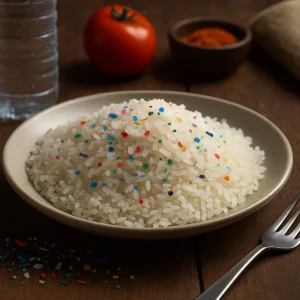Microplastics in Indian Food: A Crisis We’re Swallowing Whole

Traces of microplastics found in everyday Indian meals raise urgent questions about food safety and environmental pollution.
In recent years, growing research has revealed a disturbing reality: microplastics in Indian food have become nearly unavoidable. From grains cultivated in plastic-contaminated soil to seafood harvested from polluted waters, plastic is quietly invading India’s food supply. What once seemed like an environmental issue has now landed directly on our dining tables.
1. How Did We End Up Here?
Some stories don’t need a headline to startle you. This one begins quietly—on your lunch plate.
In India today, even a simple home-cooked meal may be laced with something we didn’t invite: plastic. Not the kind you can see or remove. We’re talking about microplastics in Indian food, and chances are, you’ve eaten them this week without knowing it.
It’s unsettling. Because while we worry about carbs, sugar, and preservatives, something much smaller—and far more dangerous—is sneaking in, bit by invisible bit.
Table of Contents
2. What Exactly Are We Eating?
Microplastics are fragments of plastic less than 5 millimeters long. Think of them as the dust of plastic—broken-down pieces from bags, bottles, wrappers, tires, even textiles.
In a country where single-use plastics are everywhere—markets, rivers, even temple offerings—these fragments don’t just vanish. They flow through sewage, cling to vegetables, float in drinking water. And one way or another, they land up in food.
In 2024, researchers in Delhi tested a variety of everyday foods—rice, lentils, seafood, bottled water. What they found was disturbing: microplastics in Indian food were not the exception. They were the norm.
3. The Plastic Trail—from Drain to Dinner
Here’s how it happens, in real life:
A farmer irrigates his field using canal water. That canal is fed by a river that’s been choking on plastic waste from cities upstream. Over time, that waste breaks down into microplastics, which settle into the soil and are absorbed by crops.
Now, let’s say you go to your local sabziwala and buy some spinach. Looks clean? Maybe. But scientists have found microplastic traces on leaves—even after washing.
Or consider fish. The kind you buy from coastal markets in Kerala or Bengal? They often ingest microplastics from polluted seas. That means you’re getting a double serving: protein, plus plastic.
You should read How Climate Migration is Forcing a Global Wake-Up Call.
4. Health Risks Nobody Talks About
What do microplastics actually do inside the human body?
That’s still being researched, but early signs aren’t encouraging. Some plastics carry toxic chemicals like phthalates and BPA—both linked to hormonal disruption. Others act like magnets for heavy metals or bacteria, carrying them deeper into our system.
Doctors at AIIMS recently raised concerns about long-term inflammation, digestive issues, even a possible rise in fertility problems due to chronic microplastic exposure. There’s also talk—still unconfirmed—of links to cancers and neurological disorders. What’s deeply troubling is how silently this is happening. Most people have no idea that their daily meals could contain microplastics in Indian food—whether it’s a seemingly fresh tomato from the mandi or a plate of fish curry by the sea. Unlike additives or preservatives, these particles aren’t listed on labels. There’s no taste, no smell, no warning—just an invisible threat we’re learning about far too late.
And here’s the real problem: you can’t test for it. There’s no standard lab report that says, “You’ve got too much plastic in your blood.” We’re eating it blind.
5. Plastic on Your Plate: A Cultural Irony
India has always had a strong culture of fresh food, open markets, and stainless-steel storage. But that’s changing fast.
Today, the rise of online food delivery means millions of meals are sent out daily in plastic containers. Go to any apartment complex in Mumbai or Gurgaon, and you’ll see bins full of takeaway boxes—still oily, still warm, leaching plastic into the food they carried.
Ironically, we think we’re upgrading our lifestyle. But with every hot meal served in cheap plastic, the exposure increases.
No wonder microplastics in Indian food are becoming a silent epidemic.
6. Is Anyone Regulating This?
Short answer? Not really.
The Food Safety and Standards Authority of India (FSSAI) doesn’t yet mandate testing food products for microplastic contamination. Nor are there any labeling requirements.
Meanwhile, countries like Germany and the Netherlands are researching how much plastic is “too much” in human food. India? We’re still debating whether to ban plastic straws.
It’s not just a regulatory gap—it’s a silence. No warnings. No ads. No government-led campaigns telling people that their meals might contain plastic.
Also go through Microplastics pollution in Indian marine environment.
7. Can You Protect Yourself? A Little, Yes.
You can’t avoid microplastics entirely. But you can reduce your exposure:
- Don’t microwave food in plastic containers
- Use steel or glass jars at home
- Filter your water with advanced filters
- Avoid over-wrapped products in supermarkets
- Support brands that use eco-friendly packaging
But individual choices only go so far. This needs structural change—policy, awareness, and serious investment in alternatives to plastic.
8. The Crisis You Can’t Taste—But Can’t Ignore
The strange thing about microplastics in Indian food is that they’re invisible. There’s no aftertaste. No sign on the surface. But they’re inside us, one grain at a time.
This is not just an environmental issue anymore. It’s a health emergency, disguised as modern convenience.
And unless we treat it like one—loudly, publicly, politically—we’ll keep eating plastic while pretending everything’s fine.

